|
Extraordinary and unforgettable, Patrick Ness’ Chaos Walking trilogy is a fantastic series in its own right, owing very little to those before it. To peg the series as another YA trilogy is to ignore how uncommonly real and whole its characters are, how fully realized its world, and how even the typeset jangles off the page. There are small imperfections here, but Chaos Walking is still a head above its peers. |
 |
|
There is no explaining, or even summarizing, Shades of Grey. Jasper Fforde has a secret stash of brilliant ideas the way most of us have junk drawers full of old pens and outdated carryout menus. Class stratification based on color perception. Killer swans. Carnivorous trees. Improved queuing. Shades of Grey is creative to the point of lunacy, outrageously witty, and totally disinterested in banality. |
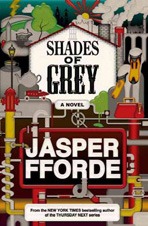 |
|
Most writers take an entire novel to do badly what Peter S. Beagle can do remarkably well in just a handful of pages. We Never Talk About My Brother is a collection of short stories that are each delivered unquestionably whole and could have been done no other way. Peter S. Beagle has such a command of voice that his characters take up no unnecessary space. The stories are masterfully crafted and are only ever too short because they end too soon. |
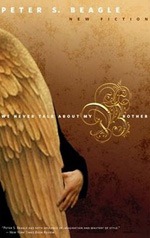 |
|
Scott Westerfeld’s Behemoth is the second book in his presumed-dead-on-arrival new series. Its predecessor, Leviathan, was too clumsy for someone with so much work behind him, but Behemoth somehow emerges from its shadows with enough wit, action and heart to recapture our hopes for the series. This steampunk version of a wildly different WWI pits Clankers (wielding machinery) against the Darwinists (wielding less-than-natural selection). Secrets, deception and plenty of fighting keeps Behemoth an engaging wartime tale. If Westerfeld can keep the momentum he’s gained, the upcoming third installation, Goliath, should be a satisfying conclusion. |
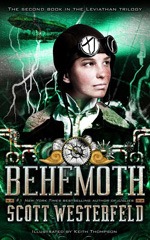 |
Back to Books ~2010 Summary
•January 23, 2011 • 1 CommentBook Review: The Forest of Hands and Teeth
•May 24, 2009 • 2 Comments

The Forest of Hands and Teeth
by Carrie Ryan
As Carrie Ryan’s first novel, The Forest of Hands and Teeth is a small step above its contemporaries. Although there is nothing new in its subject matter – visions of 28 Days Later abound – Ryan comes at it with near-solid footing. But, in spite of a strong opening and decent construction overall, The Forest of Hands and Teeth has its inadequacies, not the least of which is the nagging suspicion that the words keep piling up merely to fill space.
The constant fear of the Unconsecrated – the undead that populate the Forest that surrounds the village – is the driving force in Mary’s life. Her village, overseen by the Sisterhood and protected by the aptly named Guardians, is encircled by a fence meant to keep the undead at bay. It is taken for granted that there is no world beyond the village, and to travel beyond its boundaries means death at the hands of the Unconsecrated – and then rebirth as one of them. Only when an outsider appears does Mary begin to question whether there is something worth finding outside the haven of the village. It’s a story we’ve heard before, and will undoubtedly hear again, as Mary faces off against the Sisterhood, her family, and her village to discover the truth.
Book Review: Let Me In
•March 9, 2009 • 2 Comments

Let Me In
(New English release title: Let the Right One In)
by John Ajvide Lindqvist
Vampire lore has suffered an unintended devolution from horror to comedy over recent years, and bookshelves have no space for additional stock-quality vampire novels. Thankfully, John Ajvide Lindqvist’s first novel is anything but what has come before. Let Me In, the source for the critically acclaimed movie Let the Right One In, is equal parts horror and romance, if not exactly where expected.
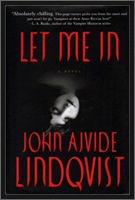 Oskar, a friendless boy living with his mother in an all-too-common nowhere, is struggling to deal with life as the target of his classmates’ cruelty. His role makes the unending loop between invisible boy and scapegoat until he meets Eli, the odd and inquisitive girl who moves into the apartment next to his. As he and Eli develop a tentative friendship, Oskar slowly realizes what she is, and he begins to understand that there are worse things than not being human.
Oskar, a friendless boy living with his mother in an all-too-common nowhere, is struggling to deal with life as the target of his classmates’ cruelty. His role makes the unending loop between invisible boy and scapegoat until he meets Eli, the odd and inquisitive girl who moves into the apartment next to his. As he and Eli develop a tentative friendship, Oskar slowly realizes what she is, and he begins to understand that there are worse things than not being human.
The story may be familiar, but it is the simultaneous innocence and wisdom of its young characters that makes Let Me In so casually heartwrenching. The ease with which Oskar accepts Eli as a vampire is only the first of many compromises as they find ways to make their need for each other more important than their differences.
While only mildly grotesque in terms of anything expected of vampire lore, Let Me In will still turn more delicate stomachs. The book’s exploration of human darkness through sadism, pedophilia, and disfigurement will leave more than a few mainstream readers appalled.
Let Me In sacrifices plausibility for horror in places, but it is a fault of any book in the genre. The prose is quick and occasionally stunted, but whether this is by Lindqvist’s design or translator Ebba Segerberg’s taste for brevity is a topic for debate.
Where Lindqvist excels — and what makes Let Me In so unlike its peers – is his knowing handling of his characters. It is Lindqvist’s multi-faceted portrayal of human cruelty that makes such a miracle of Eli’s appearance in Oskar’s life. Theirs is an impossible love and, for all Anne Rice’s tomes on the subject of vampiric angst, Oskar and Eli manage to make theirs uncomplicated — and still hauntingly sweet. Let Me In is the vampire novel that we hadn’t realized we needed.
Excerpt (p. 39):
“Aren’t you cold?”
“No.”
“Why not?”
The girl frowned, wrinkling up her face, and for a moment she looked much much older than she was. Like an old woman about to cry.
“I guess I’ve forgotten how to.”
| let me in book review let the right one in book review John Ajvide Lindqvist |  |
Rating: A-
Book Review: Elsewhere
•January 11, 2009 • 1 Comment

Elsewhere
by Gabrielle Zevin
For a story that begins after the death of its 15-year-old protagonist, Elsewhere is surprisingly rich in hope. There is an utter lack of pathos, as if the author intentionally withheld the obvious sorrow of a life cut short. Instead, Liz Hall’s life continues long after the hit-and-run, and she faces many of the same challenges she would have if she were still living. Elsewhere touches a number of issues but lingers on none of them, and provides readers with a transporting backdrop to some very human questions.

Zevin’s vision of the afterlife is a charming and well-thought-out reassurance of life after death. The newly dead are carried by the SS Nile to Elsewhere, where they are met by loved ones who had passed on before them. In Liz’s case, her grandmother awaits her arrival at the dock, having died of cancer before Liz was born. Even before they reach home, Liz transforms into the picture of teenage rebellion, rejecting her grandmother’s loving support and doing everything in her power to return to her previous life. More than just a story about death, Elsewhere is the universal message of growing up and accepting the unavoidable.
The land of Elsewhere owes its easy believability to Zevin’s attention to detail. Elsewhere is the flip side of life — the dead grow younger and eventually return to Earth as infants. It’s an interesting and complication-riddled twist on the usual scene of harps and halos, but the system seems so obvious in hindsight that it demands credibility. Smaller details, such as the Observation Decks where the dead can keep up with the day-to-day lives of those they left behind, give Elsewhere an additional nudge toward authenticity.
Zevin’s prose is straightforward and only occasionally clumsy, and her use of the present tense forces the afterlife into a sense of immediacy. Liz’s voice is fairly reliable, if only in the sense that it demonstrates a teenager’s inability to focus beyond what she wants or feels at any given moment.
If there is one shortcoming in Elsewhere, it is that Liz bothers to see so little of it. As a narrator, Liz is a less than ideal proxy for the supernatural setting, as she stoutly refuses to explore it on our behalf. Her self-imposed alienation limits our understanding of Elsewhere as well as her standing in it. Liz’s only friend disappears after the first few chapters, and her grandmother slowly fades to irrelevance. By the end, the story revolves around Liz and her love interest. The angle might suit the age but not the setting, and we can’t help but feeling the tiniest bit cheated.
While Elsewhere’s basic story may seem familiar, Zevin’s creativity buoys it above the usual fare. The sheer newness of Elsewhere breathes life into its lessons of forgiveness and acceptance. Elsewhere is charming, uncomplicated, and imaginative in a way that should prove embarrassing for readers who arrived with low expectations.
Excerpt (p. 39, paperback):
“We’re here!” Thandi is looking out the upper porthole when Liz enters the cabin. She jumps down from the top bunk and throws her solid arms around Liz, spinning her about the cabin until both girls are out of breath.
Liz sits down and gasps for air. “How can you be so happy when we’re…?” Her voice trails off.
“Dead?” Thandi smiles a little. “So you finally figured it out.”
“I just got back from my funeral, but I think I sort of knew before.”
Thandi nods solemnly. “It takes as long as it takes,” she says. “My funeral was awful, thanks for asking.”
Rating: A-
| gabrielle zevin elsewhere book review aydee |  |
Book Review: The Graveyard Book
•December 27, 2008 • 7 Comments

The Graveyard Book
by Neil Gaiman
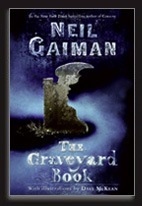 Unlike Gaiman’s earlier works, The Graveyard Book is almost strictly about atmosphere. There is the graveyard itself, which Nobody Owens calls home; the mysterious and sinister creatures that populate the night; and the ghosts, who are both otherworldly and utterly familiar. Gaiman weaves a dark mood in the first chapter that lingers right through to the end.
Unlike Gaiman’s earlier works, The Graveyard Book is almost strictly about atmosphere. There is the graveyard itself, which Nobody Owens calls home; the mysterious and sinister creatures that populate the night; and the ghosts, who are both otherworldly and utterly familiar. Gaiman weaves a dark mood in the first chapter that lingers right through to the end.
The Graveyard Book is captivating from the start, aided by the simple and yet effectively creepy illustrations by Dave McKean. The story is set as an infant escapes his family’s murderer, only to find sanctuary in the local graveyard. The kindly ghosts take him in and raise him as their own, and Bod — short for Nobody — grows up amidst all the imagination Gaiman has to offer.
Gaiman’s strength lies in his ability to think in unexpected patterns, but he has not yet perfected the art of making them work toward a common goal. Bod’s adventures in both the world of the living and the world of the dead highlight points of change or lessons learned, but the effect is never cumulative. The pacing and story stumble through numerous time leaps as Gaiman jumps to his favorite parts and abandons the rest. As the timeline vaults years to keep up with Bod’s age, the story fragments along with it. We see the pieces of Bod’s life which Gaiman has deemed important or necessary, but they never feel natural and do little to complete an overall portrait of Bod’s world.
Unsurprisingly, the quality of writing is at its worst when Gaiman works hardest at it. Some of the descriptions ring true, but far more bewilder. In an effort to keep atmosphere at the forefront of The Graveyard Book, Gaiman has turned to the familiar weapon of the purple prose writer: flat-out incomprehensibility.
The Graveyard Book, p. 194
“You will do as you are told, boy,” said Silas, a knot of velvet anger in the darkness.
There are several spots like this, in which Gaiman strains so hard to keep the mood that the readers can very nearly hear him striking the keys harder than usual.
The title of The Graveyard Book alone begs comparison to Rudyard Kipling’s The Jungle Book. But, where Mowgli has no choice but to return to the human world, Bod is less inclined to rejoin the living. His forays into the world of the living are never what he expected and almost always disappoint; and when he finally does go out into the world, he does so unarmed and unprepared.
Overall, The Graveyard Book is by no means an unpleasant read, but it leaves its audience wanting. Bod’s inability to fit in anywhere — either in the world of the dead or of the living — cast his return to life in an uncertain light. The Graveyard Book is thematically enjoyable but suffers from plotting issues that leaves it holding decidedly less than it should.
Atmospheric but lazy and ultimately disappointing, The Graveyard Book can’t match the thoroughness of Gaiman’s Anansi Boys or Neverwhere, but it should still find a ready audience among the younger set.
Excerpt:
|
Rating: C+
| neil gaiman the graveyard book book review aydee |  |
Book Review: Ink Exchange
•August 21, 2008 • 8 Comments

• Ink Exchange •
by Melissa Marr
Much like its predecessor, Ink Exchange is all sensation and no substance. Rather than using the book to improve upon the world of fey, Marr lets her impatience with topics already covered in Wicked Lovely rob Ink Exchange of any sort of depth, and the story becomes a flashily sensuous joyride that never dips beneath the surface.
Marr’s second book is a weaker carbon copy of her first, as if she’d merely traced over the lines of Wicked Lovely and inserted less compelling characters. Once again, a human girl is tempted by the king of a fey court who believes that she is destined to belong to him. Once again, she must find the strength to overcome his conviction and his deceptions in order to save herself. However, where Aislinn had a long-standing dislike of the fey and knew how to fight back, Leslie is little more than a “broken toy,” as the Dark King deemed her in the first chapter. Marr tried to give us a heroine who had seen and survived living hell, but Leslie falls far short of the task, and does little more in the end than give others permission to save her.
 Unlike Aislinn, whose Sight enabled her to see the invisible world of fey, Leslie is a victim of her own life and others’. Stuck with an alcoholic father and abusive brother, Leslie finds refuge in her friends and in the tattoo she chooses from Rabbit’s shop. Unfortunately, Rabbit is fey, and Leslie’s tattoo turns her into a siphon for emotions, which the Dark King uses to sustain his followers.
Unlike Aislinn, whose Sight enabled her to see the invisible world of fey, Leslie is a victim of her own life and others’. Stuck with an alcoholic father and abusive brother, Leslie finds refuge in her friends and in the tattoo she chooses from Rabbit’s shop. Unfortunately, Rabbit is fey, and Leslie’s tattoo turns her into a siphon for emotions, which the Dark King uses to sustain his followers.
Without Wicked Lovely to bolster it, Ink Exchange has no history and even less complexity. The world of fey, so haphazardly described in Wicked Lovely, is even more scattered this time around. And, since we’ve already seen Seth struggling to accept the supernatural, Leslie’s reaction is an even briefer recap of his denial: little more than an impatient pause on Marr’s way to bigger and more dramatic things.
Throughout Ink Exchange, suspense is nonexistent. By the time Leslie’s life begins to change, we’re well aware of what’s really going on. Marr has little interest in hiding the puppets’ strings, as we’re given full access to all of the characters, human and fey alike. There are no surprises because there are no motives that aren’t described by the individual harboring them. At every step, we know what drives the Dark King, what haunts Leslie, and what choices those who love them have to make. Like Wicked Lovely, Ink Exchange is more a melodrama about free will than a fantasy. Once again, human strength is pitted against the depravity of the supernatural, with expected outcomes on both sides.
Emotions run high throughout Ink Exchange, some well beyond the point of plausibility and into absurdity. A tense staring match between the Dark King and the Summer Queen is a melee of flame and shadow, which is enticing at first but quickly grows tiring as none of the fey can seem to have a conversation without setting something ablaze. Most of it runs past –- and through –- the heroine, who spends at least a third of the book as a magic addict and couldn’t be any less interested in heroics. Somewhere near the midpoint, Leslie’s usefulness disappears entirely, leaving others to bicker amongst themselves and coax the plot into action again.
Unlike Wicked Lovely, Marr’s second book has no clear goal and ends up being a showcase for uncontrollable and nearly poisonous emotions. The humans learn to believe in themselves, the fey learn responsibility and mercy, and attraction flows in every direction. A vaguely guilty read without the follow-through, Ink Exchange takes the first book’s strong points and inverts them, leaving us with a few hundred pages of angst but very little worth remembering.
Excerpt (p. 23):
|
Rating: C-
| ink exchange review melissa marr book review aydee |  |
Book Review: Wicked Lovely
•August 10, 2008 • 2 Comments

• Wicked Lovely •
by Melissa Marr
Teen fantasy is in desperate need of new blood, but it doesn’t appear that it will be getting some any time soon. Wicked Lovely, Melissa Marr’s first book and her official launch into the magical world of fey, is a tough-girl story set against a borrowed fantasy background. It’s hard not to be drawn into the world of the Summer Court and the fey that populate it, but it isn’t Marr’s world. It’s a fact that rings truer with each snippet of faery lore quoted beneath chapter headings, practically as a disclaimer.
Wicked Lovely is the story of Aislinn, a teen girl whose ability to see fey folk makes her life a constant lesson in turning the other cheek and a struggle to keep the secret of her family’s Sight under wraps. However, the Summer King has decided that Aislinn is the one: the mortal who will become his queen. Being the modern-day women’s-rights sort of girl that she is, Aislinn has no interest in falling for his scheme; and the battle of the Summer Queen’s succession pulls the Summer King, Aislinn and her love interest into a mess that centuries of faery lore can’t keep in check.
If Wicked Lovely sounds exciting, that’s because it very nearly is. When not dealing with Aislinn and Seth’s are-we-or-aren’t-we dilemma, the plot is a seizure of allegiances and suspicions, conveniently skipping over faery lore that Marr has little or no interest in explaining. In addition to keeping the book short, this relative distance from any complexity in faery life results from the fact that it isn’t Marr’s world to begin with, and she treats it as public knowledge. Much like vampires, ghosts and witches before them, faeries have become yet another bargain bin folklore to build teen drama around.
In fact, the most interesting stories in Wicked Lovely are the subplots. Since Aislinn’s aware that she’s humanity’s only hope for fending off eternal winter, there’s never any tension over whether she will or won’t; it merely becomes a matter of how. The real page-turning lies in her affection for Seth (who, in spite of cringe-worthily frequent descriptions of his piercings, unorthodox lifestyle and general hotness, seems like an unnaturally decent guy). There’s no fun to be had in Wicked Lovely’s scraps of faery lore, so we delegate the weight of the novel to its subplots.
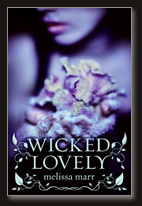 With the book safely categorized as recycled fantasy, any sort of saving grace must be sought in Marr’s writing. Unfortunately, the one place where it might have shone is where Wicked Lovely falls surprisingly short. An overuse of asides — never fewer than one per page, sometimes as many as three — transforms the narrative into the jerky commentary of announcers shouting over a sporting event.
With the book safely categorized as recycled fantasy, any sort of saving grace must be sought in Marr’s writing. Unfortunately, the one place where it might have shone is where Wicked Lovely falls surprisingly short. An overuse of asides — never fewer than one per page, sometimes as many as three — transforms the narrative into the jerky commentary of announcers shouting over a sporting event.
Perhaps the best thing that Wicked Lovely has going for it is the cover design, which continues on Marr’s second book, Ink Exchange. Still, the characters are so driven that we can’t help but be driven along with them. The writing demands skimming, and the story itself is unapologetic fanfiction of faery lore; but with a level-headed protagonist and a demanding supporting cast, Wicked Lovely is hardly the worst of the teen fiction crop.
Excerpt (pp. 9-10):
|
Rating: C
| wicked lovely review melissa marr book review aydee |  |
Book Review: Fly by Night
•July 19, 2008 • 1 Comment

Fly by Night
by Frances Hardinge
Frances Hardinge is one of precious few who are able to write without accountability. That is, she gives us something to read without ever showing herself. Fly by Night is an engaging display of wit (both by its protagonists and its writer), comedy, and devilry; but the overall plot falls far short of what’s promised and dooms the book to the realm of stories-that-should-have-been.
On the one hand, Hardinge has a surprisingly firm grip on lovable characters. Mosca Mye, her con-man companion, and the ill-tempered goose Saracen wreak havoc on a world of controlled knowledge, with hilarious results. Unlike so many writers, Hardinge has the good sense to give her characters free reign and allows them to move without strings or guidance. It’s rare that characters compel themselves forward as well as hers do, and their energy is refreshing.
It’s too difficult to summarize the plot of Fly by Night. Instead, it might be more accurate to say that the story is a series of schemes that fall just short of success. The tale begins as Mosca flees her hometown of Chough for a chance at a more exciting life, rescuing an imprisoned con artist and burning her uncle’s mill to the ground in the process. From there, it’s a visible effort for all of the characters to stay on their toes through a murder, a four-way guild war, and too many betrayals to count.
Hardinge’s utter lack of pomposity and her willingness to spare her characters their dignity is enough to blur her gender. I hadn’t realized she was a woman until the end of the second chapter, at which point I had to check the jacket flap to be sure. The sort of easy confidence with humor is usually a hallmark of men’s comedic writing, and it’s nice to see a woman attack it so well.
Unfortunately, Fly by Night is far from perfect. The chapters are named A-Z, much like Sue Grafton’s mystery series, and they suffer the same sort of ill-inspired titles. The subplots never quite manage to disentangle themselves, even by the end of the book. There are too many guilds and alliances to keep track of, and Hardinge has no interest in getting us up to speed.
The cover of the book is stamped with a warning that reads, “Imagine a world in which all books have been BANNED!”; but the issue is largely invisible throughout the story, and the cover itself seems like an afterthought. Hardinge’s attempt to address the philosophy of free press — and, surprisingly, religious freedom — arrives in the form of an unexpected bit of speechifying by the protagonist at gunpoint. It’s an ending that so many writers attempt to cram into their stories that it’s practically a given tragedy.
Flaws aside, Fly by Night is a massively enjoyable read, even if it is one carried by its writing rather than its story. Not even the blatant and belated attempts to critique freedom of expression were enough to overcome the laugh-out-loud prose. When read with an open mind and a poor memory, Fly by Night is a perfectly decent way to spend an afternoon.
Excerpt (pp. 26-27):
|
Rating: B
| frances hardinge fly by night book review aydee |  |
Book Review: The Canning Season
•July 19, 2008 • 2 Comments

I’ve worked for the same itty-bitty library in an itty-bitty town for six years now. It’s nearly a one-stoplight affair (actually, there are seven or eight), but the town isn’t exactly backwater. It’s easiest to think of everything within its boundaries as a hoighty-toighty neighborhood in which every other vehicle is a Mercedes or BMW; and if you hold a job in that town, no matter what it is, you’re inconsequential.
After six years of being inconsequential, I’m still amazed by how the residents manage to stare down their noses without tripping.
But, more often than not, their scorn is silent. So my only real opportunity to mock them comes when they decide to remind us that whatever it is we’re doing, we’re not doing it well enough.
In this case, it means our book selections.
On Thursday, a copy of Polly Horvath’s The Canning Season was returned with a note paperclipped to the front cover. The note was addressed, in careful longhand, to the children’s librarians, and the snippets I do remember went something like this:
“…National Book Award, which used to stand for quality…”
“…a suicide described in graphic detail…”
“…teacher who refers to her students as ‘little f—ks.” (censorship not mine)
Now, Horvath is one of my favorite authors. She’s unflinchingly real and has no understanding of fluff. If anything, I’d have to say she’s got the best shot at being The Next Roald Dahl. (The title’s been haphazardly assigned to J. K. Rowling on occasion, but I’m still puzzling over that one.) Horvath is effortlessly witty and is happy to provide readers with a much-needed breath of realistic air, even if it smells a bit like old socks.
The book in question is a teen book — so labeled and so shelved — and could hardly be mistaken for another installment of Henry and Mudge. Actually, the only thing that separates teen books from adult books is the subject matter. The protagonists are usually teens (sometimes teens with special powers), but that’s really all the difference there is. Everything else is free game.
When the group of us finished scratching our heads at the circulation desk, the children’s librarian pointed out that central selection sends us the books, and that the system automatically purchases any National Book Award winners without so much as blinking.
While the others were busy scouring the note for further gold, I quietly spirited the book away so that I could read it myself. As expected, The Canning Season is classic Horvath: unapologetic, uproarious and unforgettable. Thirteen-year-old Ratchet is sent to spend the summer with her two wonderfully insane aunts, who recall their quirky lives with such offhandedness that we have no choice but to envy them. Or, in the case of my library’s lone critic, revile them.
To address the complaints: yes, a suicide is recounted in cartoonish detail (“I don’t think she quite expected [the head] to bounce like that…”); yes, the tutor referred to her spoilt charges as “little fucks” (rightfully so, in her mind); and yes, the National Book Award still does stand for quality. And Horvath has earned it without question.
It was our collective decision that whoever penned the note should be steered clear of all books not pertaining to knitting or gardening, or perhaps anything giving off a faint aroma of imagination.
Or better yet, lock the offender in a room with any number of today’s 13-year-olds. When her ears have been properly scorched from the sides of her head, Horvath will look quite tame.
| the canning season aydee |  |


 I’ve been trying to decide exactly who might find the novel more bewildering: those who’ve played the game, or those who haven’t. On the one hand, those of us who’ve played the Metal Gear Solid games know Solid Snake with an imagined intimacy that probably keeps David Hayter from a good night’s sleep. We love the eternally just-rolled-out-of-bed timbre of his voice, we cherish his oft-deserved witticisms, and we thrive on his woefully frequent lapses in tact.
I’ve been trying to decide exactly who might find the novel more bewildering: those who’ve played the game, or those who haven’t. On the one hand, those of us who’ve played the Metal Gear Solid games know Solid Snake with an imagined intimacy that probably keeps David Hayter from a good night’s sleep. We love the eternally just-rolled-out-of-bed timbre of his voice, we cherish his oft-deserved witticisms, and we thrive on his woefully frequent lapses in tact.



 #1: Questionable torture
#1: Questionable torture So, should you read Metal Gear Solid?
So, should you read Metal Gear Solid?
